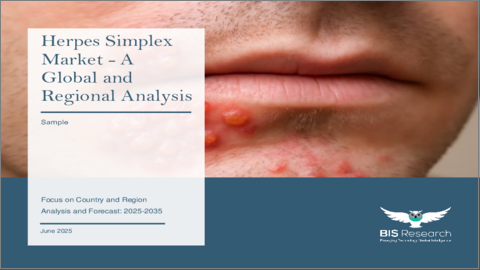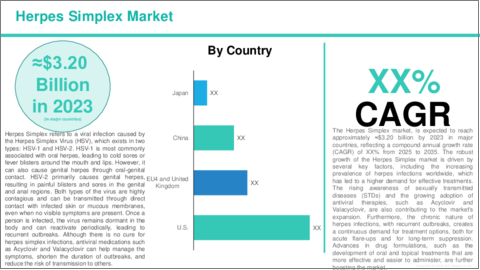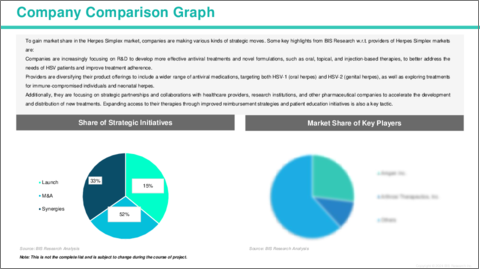|
|
市場調査レポート
商品コード
1759279
単純ヘルペスの世界市場:地域・国別の分析・予測 (2025-2035年)Herpes Simplex Market - A Global and Regional Analysis: Focus on Country and Region - Analysis and Forecast, 2025-2035 |
||||||
カスタマイズ可能
|
|||||||
| 単純ヘルペスの世界市場:地域・国別の分析・予測 (2025-2035年) |
|
出版日: 2025年06月30日
発行: BIS Research
ページ情報: 英文 100 Pages
納期: 1~5営業日
|
全表示
- 概要
- 図表
- 目次
単純ヘルペス市場の主要な成長要因の一つは、世界的および特定の層における感染症の有病率の増加です。
病気に対する認知が高まり、診断と治療を求める人が増えるにつれて、抗ウイルス薬や治療への需要が増加しています。さらに、アシクロビル (Acyclovir)、バラシクロビル (Valacyclovir)、ファムシクロビル (Famciclovir) といった、より効果的かつアクセスしやすい抗ウイルス薬の進歩が、市場の成長を後押ししています。
また、予防への関心の高まりと、再発性のある感染の継続的な管理ニーズも市場に影響を与えています。医療システムは、患者ケアの向上や感染拡大の抑制に注力しており、製薬企業や医療機関は、より効率的な新たな治療法の研究開発への投資を進めています。さらに、性に関する健康問題の受容が進み、偏見が軽減されてきたことで、より多くの人々がヘルペスの治療を求めるようになり、市場拡大につながっています。
市場成長にもかかわらず、いくつかの課題が引き続きその進展を妨げています。最大の課題の一つは、完治できる治療法が存在しないことです。抗ウイルス薬によって症状を管理し、発症頻度を減らし、感染リスクを低下させることは可能ですが、体内からウイルスを完全に排除することはできません。これにより、長期的な解決策がなく、患者の間で治療への不満や治療継続の中断 (コンプライアンスの低下) につながることがあります。
また、単純ヘルペスに対する誤解や偏見も診断・治療の障壁となっています。多くの人々は社会的・性的な偏見を恐れて、医療機関での相談や診断を避ける傾向があり、そ感染率をさらに悪化させる可能性があります。このような社会的偏見は市場成長を制限する要因にもなり、人々が適切な治療を受けることをためらわせています。
さらに、抗ウイルス薬に対する耐性の出現も課題です。時間の経過とともに、ヘルペスウイルスは抗ウイルス薬に対する耐性を持つようになり、既存の治療法の効果が低下する可能性があります。これにより、治療効果を維持するためには継続的なイノベーションや新たな治療法の開発が不可欠となっています。
最後に、治療の費用とアクセスの問題も一部の患者にとっては大きな障壁です。抗ウイルス薬は効果的ですが、価格が高く、すべての人が利用できるわけではありません。特に、低所得地域や開発途上国では治療へのアクセスが制限されており、効果的な治療法の普及を妨げ、世界規模での感染制御の進展を阻んでいます。
当レポートでは、世界の単純ヘルペスの市場を調査し、主要動向、市場影響因子の分析、法規制環境、臨床試験の動向、市場規模の推移・予測、各種区分・地域/主要国別の詳細分析、競合情勢、主要企業のプロファイルなどをまとめています。
目次
エグゼクティブサマリー
第1章 世界の単純ヘルペス市場:業界展望
- 市場動向
- 規制の枠組み
- 疫学分析
- 臨床試験分析
- 市場力学
- 影響分析
- 市場促進要因
- 市場の課題
- 市場機会
第2章 単純ヘルペスの世界市場:地域別
- 北米
- 主な調査結果
- 市場力学
- 市場規模と予測
- 欧州
- 主な調査結果
- 市場力学
- 市場規模と予測
- アジア太平洋
- 主な調査結果
- 市場力学
- 市場規模と予測
- 世界のその他の地域
- 主な調査結果
- 市場力学
- 市場規模と予測
第3章 世界の単純ヘルペス市場:競合情勢と企業プロファイル
- 主な戦略・展開
- M&A
- 相乗効果のある活動
- 事業拡大と資金調達
- 製品の発売と承認
- その他の活動
- 企業プロファイル
- Teva Pharmaceutical Industries Ltd.
- Novartis AG
- Emcure Pharmaceuticals Ltd.
- Viatris, Inc.
- Apotex Inc.
- Glenmark Pharmaceuticals Inc.
- GSK plc
- Sanofi
第4章 調査手法
List of Figures
- Figure: Global Herpes Simplex Market (by Region), $Billion, 2024 and 2035
- Figure: Global Herpes Simplex Market Key Trends, Analysis
List of Tables
- Table: Global Herpes Simplex Market Dynamics, Impact Analysis
- Table: Global Herpes Simplex Market (by Region), $Billion, 2024-2035
Global Herpes Simplex Market, Analysis and Forecast: 2025-2035
Herpes Simplex is a viral infection caused by the Herpes Simplex Virus (HSV), with two primary types: HSV-1 and HSV-2. HSV-1 typically leads to oral herpes, manifesting as cold sores or fever blisters around the mouth and lips, though it can also cause ocular herpes and, through oral-genital contact, genital herpes. HSV-2 is primarily responsible for genital herpes, causing painful sores and blisters in the genital and anal areas, but it can also result in oral herpes, though this is less common. The virus is highly contagious, transmitted through direct contact with infected skin, mucous membranes, or bodily fluids, even in the absence of visible symptoms. Once contracted, the virus remains dormant in the body and can reactivate later, leading to recurrent outbreaks. Although there is no cure for Herpes Simplex, antiviral medications such as Acyclovir, Valacyclovir, and Famciclovir can manage symptoms, reduce the severity and duration of outbreaks, and lower the risk of transmission.
One of the key drivers of the Herpes Simplex market is the increasing prevalence of the infection, both globally and within specific demographics. As awareness of the disease grows and more individuals seek diagnosis and treatment, there is a rising demand for antiviral medications and therapies. Additionally, advancements in treatment options, including more effective and accessible antiviral drugs such as Acyclovir, Valacyclovir, and Famciclovir, are driving market growth.
The market is also influenced by the growing emphasis on prevention and the need for ongoing management of recurrent outbreaks. As healthcare systems focus on improving patient care and reducing transmission rates, both pharmaceutical companies and healthcare providers are investing in research and development to offer new, more efficient treatments. Furthermore, the increased acceptance and de-stigmatization of sexual health issues have encouraged more people to seek out treatments for herpes simplex, contributing to the expansion of the market.
Despite the growth of the Herpes Simplex market, several challenges continue to hinder its progress. One of the primary challenges is the lack of a permanent cure for the infection. While antiviral medications can manage symptoms, reduce the frequency of outbreaks, and lower transmission risk, they do not eradicate the virus from the body. This limits long-term solutions for patients, and the persistent nature of the disease often leads to patient frustration and non-compliance with treatment regimens.
Additionally, misconceptions and stigma surrounding Herpes Simplex can prevent individuals from seeking diagnosis and treatment. Many people fear social or sexual stigma, which can delay intervention and diagnosis, further exacerbating transmission rates. This societal stigma can also limit market growth, as individuals may hesitate to seek medical care or pursue treatment options.
Another challenge is the development of antiviral resistance. Over time, the Herpes Simplex Virus may develop resistance to antiviral medications, reducing the effectiveness of existing treatments. This presents a need for ongoing innovation and the development of new therapeutic options to stay ahead of resistance.
Finally, cost and accessibility can be barriers for some patients. While antiviral medications are effective, they can be expensive, and not all individuals have access to these treatments, particularly in low-income regions or developing countries. This can hinder the widespread adoption of effective therapies and stall progress in controlling the disease on a global scale.
The global herpes simplex market is highly competitive, with several leading companies driving innovation and market growth, such as Teva Pharmaceutical Industries Ltd., Novartis AG, Emcure Pharmaceuticals Ltd., Viatris, Inc., Apotex Inc., Glenmark Pharmaceuticals Inc., GSK plc, and Sanofi. These companies are focused on developing advanced antiviral treatments, expanding their product portfolios, and enhancing patient access to therapies, contributing significantly to the market's expansion. Their ongoing research and development efforts, along with strategic collaborations, play a crucial role in advancing treatment options and addressing the unmet needs of individuals affected by herpes simplex.
Market Segmentation:
Segmentation 1: by Region
- North America
- Europe
- Asia-Pacific
- Rest of the World
The global Herpes Simplex market is undergoing significant transformation, fueled by emerging trends that are reshaping the treatment landscape. Advancements in antiviral therapies, including novel drug classes and combination therapies, are enhancing the effectiveness and reducing resistance to treatments.
The ongoing development of vaccine candidates, with promising results in clinical trials, offers potential long-term protection against HSV infections. Additionally, the rise of telemedicine and digital health tools is increasing access to care and reducing stigma, allowing for remote consultations and AI-powered diagnostic support.
The market is also witnessing a shift toward personalized, patient-centric care, with tailored treatment regimens that account for individual patient profiles. Furthermore, the Herpes Simplex market is expanding globally, with North America leading the market while the Asia Pacific region is expected to experience the fastest growth due to improved healthcare infrastructure and rising awareness. These trends are driving market growth, fostering innovation, and improving outcomes for individuals affected by Herpes Simplex.
Table of Contents
Executive Summary
Scope and Definition
Market/Product Definition
Inclusion and Exclusion
Key Questions Answered
Analysis and Forecast Note
1. Global Herpes Simplex Market: Industry Outlook
- 1.1 Introduction
- 1.2 Market Trends
- 1.3 Regulatory Framework
- 1.4 Epidemiology Analysis
- 1.5 Clinical Trial Analysis
- 1.6 Market Dynamics
- 1.6.1 Impact Analysis
- 1.6.2 Market Drivers
- 1.6.3 Market Challenges
- 1.6.4 Market Opportunities
2. Global Herpes Simplex Market (Region), ($Billion), 2023-2035
- 2.1 North America
- 2.1.1 Key Findings
- 2.1.2 Market Dynamics
- 2.1.3 Market Sizing and Forecast
- 2.1.3.1 North America Herpes Simplex Market, by Country
- 2.1.3.1.1 U.S.
- 2.1.3.1 North America Herpes Simplex Market, by Country
- 2.2 Europe
- 2.2.1 Key Findings
- 2.2.2 Market Dynamics
- 2.2.3 Market Sizing and Forecast
- 2.2.3.1 Europe Herpes Simplex Market, by Country
- 2.2.3.1.1 Germany
- 2.2.3.1.2 U.K.
- 2.2.3.1.3 France
- 2.2.3.1.4 Italy
- 2.2.3.1 Europe Herpes Simplex Market, by Country
- 2.3 Asia Pacific
- 2.3.1 Key Findings
- 2.3.2 Market Dynamics
- 2.3.3 Market Sizing and Forecast
- 2.3.3.1 Asia Pacific Herpes Simplex Market, by Country
- 2.3.3.1.1 China
- 2.3.3.1.2 Japan
- 2.3.3.1 Asia Pacific Herpes Simplex Market, by Country
- 2.4 Rest of the World
- 2.4.1 Key Findings
- 2.4.2 Market Dynamics
- 2.4.3 Market Sizing and Forecast
3. Global Herpes Simplex Market: Competitive Landscape and Company Profiles
- 3.1 Key Strategies and Development
- 3.1.1 Mergers and Acquisitions
- 3.1.2 Synergistic Activities
- 3.1.3 Business Expansions and Funding
- 3.1.4 Product Launches and Approvals
- 3.1.5 Other Activities
- 3.2 Company Profiles
- 3.2.1 Teva Pharmaceutical Industries Ltd.
- 3.2.1.1 Overview
- 3.2.1.2 Top Products / Product Portfolio
- 3.2.1.3 Top Competitors
- 3.2.1.4 Target Customers/End-Users
- 3.2.1.5 Key Personnel
- 3.2.1.6 Analyst View
- 3.2.2 Novartis AG
- 3.2.2.1 Overview
- 3.2.2.2 Top Products / Product Portfolio
- 3.2.2.3 Top Competitors
- 3.2.2.4 Target Customers/End-Users
- 3.2.2.5 Key Personnel
- 3.2.2.6 Analyst View
- 3.2.3 Emcure Pharmaceuticals Ltd.
- 3.2.3.1 Overview
- 3.2.3.2 Top Products / Product Portfolio
- 3.2.3.3 Top Competitors
- 3.2.3.4 Target Customers/End-Users
- 3.2.3.5 Key Personnel
- 3.2.3.6 Analyst View
- 3.2.4 Viatris, Inc.
- 3.2.4.1 Overview
- 3.2.4.2 Top Products / Product Portfolio
- 3.2.4.3 Top Competitors
- 3.2.4.4 Target Customers/End-Users
- 3.2.4.5 Key Personnel
- 3.2.4.6 Analyst View
- 3.2.5 Apotex Inc.
- 3.2.5.1 Overview
- 3.2.5.2 Top Products / Product Portfolio
- 3.2.5.3 Top Competitors
- 3.2.5.4 Target Customers/End-Users
- 3.2.5.5 Key Personnel
- 3.2.5.6 Analyst View
- 3.2.6 Glenmark Pharmaceuticals Inc.
- 3.2.6.1 Overview
- 3.2.6.2 Top Products / Product Portfolio
- 3.2.6.3 Top Competitors
- 3.2.6.4 Target Customers/End-Users
- 3.2.6.5 Key Personnel
- 3.2.6.6 Analyst View
- 3.2.7 GSK plc
- 3.2.7.1 Overview
- 3.2.7.2 Top Products / Product Portfolio
- 3.2.7.3 Top Competitors
- 3.2.7.4 Target Customers/End-Users
- 3.2.7.5 Key Personnel
- 3.2.7.6 Analyst View
- 3.2.8 Sanofi
- 3.2.8.1 Overview
- 3.2.8.2 Top Products / Product Portfolio
- 3.2.8.3 Top Competitors
- 3.2.8.4 Target Customers/End-Users
- 3.2.8.5 Key Personnel
- 3.2.8.6 Analyst View
- 3.2.1 Teva Pharmaceutical Industries Ltd.





